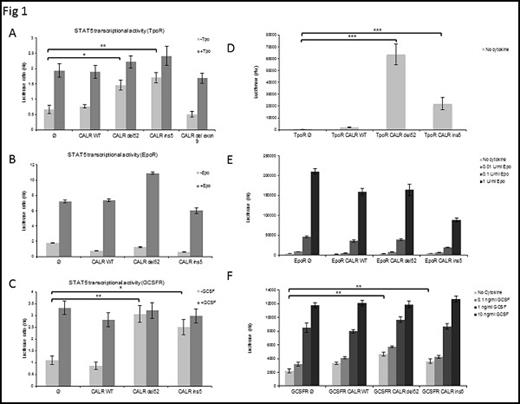The major BCR-ABL1–negative myeloproliferative neoplasms (MPNs) include polycythemia vera (PV), essential thrombocythemia (ET), and primary myelofibrosis (PMF). These chronic myeloid malignancies are caused by constitutive activation of the JAK-STAT pathway producing elevated blood counts, most often through JAK2 V617F mutations.1 Mutations in the thrombopoietin receptor (TpoR/MPL) are also found in patients with ET and PMF.2 In 2013, mutations in exon 9 of the C-terminal domain of the calreticulin (CALR) gene were identified in a significant subset of ET and PMF, but not PV.3,4 The mutations uniformly result in a 1-base pair (bp) frameshift which in turn leads to loss of the endoplasmic reticulum retention sequence, or KDEL. Two major subtypes of CALR mutations have been identified, which account for the vast majority of mutations. The 52 bp deletion ([del52]; type 1) is more commonly associated with myelofibrosis than the 5 bp insertion ([ins5]; type 2).5,6 The mechanism by which CALR mutations lead a MPN phenotype has puzzled investigators since their discovery.
STAT5 Transformation Activity. CALR mutants specifically activate TpoR leading to cell transformation. γ2A cells were transfected with JAK2, STAT5 and CALR wild type (wt) or the indicated mutants in the presence of TpoR (A), EpoR (B), GCSFR (C). Luciferase assay was performed using the firefly reporter, Spi-Luc/STAT5 (STAT5-luc) and pRL-TK renilla luciferase for normalization. Ba/F3 cells stably transduced with CALR constructs together with TpoR (D), EpoR (E) or GCSFR (F) were cultured for 3 days, in absence of cytokines. Positive controls of Epo and GCSF treatment are shown for Ba/F3 EpoR and GCSFR cells, respectively. Relative viability was measured using CellTiter-Glo technology. Statistical analysis (jmp pro11) was performed by the non-parametric multiple comparisons Steel’s test with a control group; *p<0.001. Used with permission.
STAT5 Transformation Activity. CALR mutants specifically activate TpoR leading to cell transformation. γ2A cells were transfected with JAK2, STAT5 and CALR wild type (wt) or the indicated mutants in the presence of TpoR (A), EpoR (B), GCSFR (C). Luciferase assay was performed using the firefly reporter, Spi-Luc/STAT5 (STAT5-luc) and pRL-TK renilla luciferase for normalization. Ba/F3 cells stably transduced with CALR constructs together with TpoR (D), EpoR (E) or GCSFR (F) were cultured for 3 days, in absence of cytokines. Positive controls of Epo and GCSF treatment are shown for Ba/F3 EpoR and GCSFR cells, respectively. Relative viability was measured using CellTiter-Glo technology. Statistical analysis (jmp pro11) was performed by the non-parametric multiple comparisons Steel’s test with a control group; *p<0.001. Used with permission.
To examine the role of CALR and its interactions with cytokine receptors, Drs. Ilyas Chachoua and Stephan Constantinescu and colleagues employed retroviruses to infect cell lines with mutant CALR. The cytokine-dependent BaF3 cell line was infected with retroviral plasmid containing CALR wild-type, del52, or ins5 sequences, as well as one of several cytokine receptors including MPL, the EPO receptor (EpoR), and G-CSF receptor (GCSFR). These cells were induced to have autonomous growth with mutant CALR and MPL, and, to a limited extent, GCSFR (See Figure). These findings showed that mutant CALR requires MPL and does not interact with EpoR.
To explore the role of JAK2 in MPL activation, the JAK2-deficient γ-2a cell line was used. These cells could not induce MPL activation in the presence of mutant CALR, indicating the requirement of JAK2. Further emphasizing this point, the JAK2 inhibitor ruxolitinib was successful in inhibiting proliferation of Ba/F3 cells with mutant CALR. Interestingly, the addition of a MEK-ERK inhibitor, but not a PI3-K inhibitor, provided a synergistic effect.
Alteration of MPL N-glycosylation sites blocked mutant CALR from activating MPL. This activation was independent of Tpo, as demonstrated by Tpo-binding deficient MPL, which could still be activated by mutant CALR. The authors hypothesize that CALR mutants may stabilize one of the active interfaces of MPL in addition to directly interacting with MPL. This could explain why CALR mutants do not interact with other N-glycosylated mutated receptors, and why the del52 and ins5 have different clinical phenotypes. Finally, this group verified the importance of the MPL/JAK2 signaling pathway in primary cells from CALR-mutated ET patients. Short hairpin RNAs targeting MPL or JAK2 were successful in inhibiting Tpo-independent colony formation.
Similar findings were presented at the 2015 ASH annual meeting by Dr. Shannon Elf and colleagues from the laboratory of Dr. Ann Mullally. By overexpressing CALR-del52 in the cytokine dependent BaF3 cell line, IL-3 independent growth was achieved in cells expressing MPL, but not in cells expressing EpoR. These cells exhibited increased phosphorylation of MPL, JAK2, and STAT3, and the JAK1/JAK2 inhibitor ruxolitinib could block STAT3 activation in a phospho-flow cytometry assay. A variety of mutant CALR proteins were studied, and it was found that the positive charge of the C-terminus was critical for its transforming capacity. This mutant CALR physically interacts with MPL, as shown by co-immunoprecipitation. These findings are in agreement with Dr. Chachoua and colleagues by showing that mutant CALR interacts with MPL and signals through the JAK-STAT pathway.
In Brief
This research provides important insights into the pathophysiology for CALR-mutated MPN and proposes an intriguing mechanism of a mutated chaperone protein inducing cytokine activation. These findings suggest a novel signaling paradigm whereby a mutated CALR undergoes a different cellular localization from the wild-type protein and induces activation of MPL at the N-glycosylation site through JAK2, independent of Tpo. The observation that different mutations in CALR may stabilize different active interfaces of MPL provides a possible explanation for different clinical phenotypes. Importantly, by demonstrating a JAK-STAT signaling pathway that is different from the JAK2 V617F driven neoplasms, these data offer hope for new therapeutic opportunities.
References
Competing Interests
Dr. Lynch and Dr. George indicated no relevant conflicts of interest.

